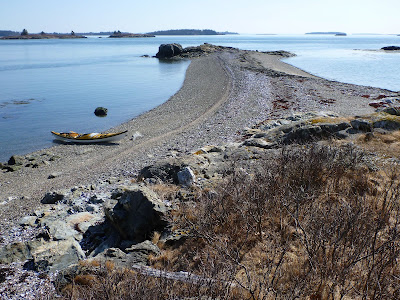 |
| Osprey nest at Sutton Island |
The forecast for Thursday was amazing: clear, not too windy and air temps... in the high seventies to low eighties! In March! Despite these overly-hot temperatures, Nate and I had plans to get out. With the air forty degrees warmer than the water, we figured we might be roasting in our drysuits, but we’d tough it out. Lighten the base layers and skip the gloves... dip your hand in the water every now and then as a reminder. This weather could prove more dangerous than on colder days, since it will probably lure unprepared paddlers out onto water that will kill them if they capsize. Just last weekend, unprepared paddlers died on Lake Michigan and in Ontario, probably due to the cold water.
 | |||
| I don't know what to say here- yes, we like to put our bows into things. |
We arrived at the east end as high tide neared. Despite all the houses on the island, most of it feels fairly undeveloped, especially the east end, where great rocky fins and dikes extend down into the water, creating chasms and passages to paddle through.
On the northeast end of Little Cranberry Island, we decided to check-out a feature that we’d paddled past before without noticing. Why is Marsh Head called Marsh Head? Well, it may have something to do with the marsh. We did a ten-foot portage to get in, then followed a winding, creek-like path to the east end of the island.
From the calm waters of the marsh, we heard a roaring, hissing sound just beyond the trees to the south, and it took a moment to recognize the crash of surf. The marsh ended at a deposit of rock and sand. Again, we got out and carried the boats just over the hill, launching into small waves on the east end.
We had plenty of time to cover the six or so miles out to Baker Island, but we dilly-dallied: osprey nests, winding rocky passages, a hidden marsh. These are the things that make it fun, that keep a day of paddling from turning into an accounting of passing miles.
On the other hand, by the time we arrived at Baker, we didn't have much time for dilly-dallying. We faced more wind, and the fairly minor swell amounted to some decent waves here and there as we paddled around the southern side.
At one point, I looked over at Nate and thought he was paddling a little close to the ledge right beside him. Then one of those sneaky-big waves came in and dropped him on top of the ledge. This circumstance happens often enough that it must have some sort of cool name... but I don't know it. This time he had to get out of his boat and find a better spot to relaunch.
Then it was time to boogie back to Northeast Harbor. As we passed the islands, the land-warmed air blew across our decks- a reminder of the eighty-degree land forecast. We'd been perfectly comfortable in drysuits, even a little chilled now and then out in the wind and waves. It was hard to believe how warm it felt back at the launch. We rode along in Nate's truck in t-shirts, elbows out the windows... with NPR on the stereo. We picked up his kids at a friend's, where they were squirting each other with a garden hose, and everyone- parents and kids seemed to be congregating in the street... just like us, making the most of a warm day in March.
























